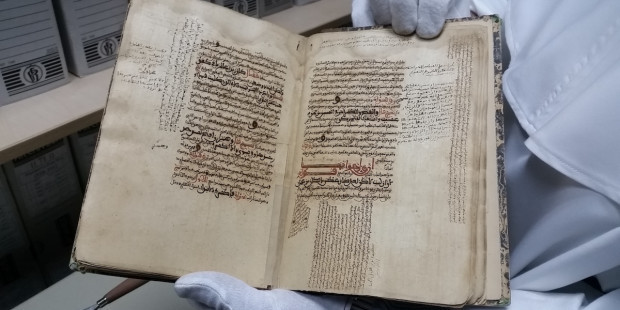An exposition at the Dominican friary of Santa Maria Sopra Minerva in Rome, which runs until June 17, offers a collection of Iraqi manuscripts never shown to the public before—dating from between the 13th and 19th centuries—as well as exceptional photographs from the old photo archive of the Dominican friary in Mosul (Iraq).
These are the treasures that, along with the desire to live the Gospel in a land of ancient Christianity, inspired the Order of Preachers to establish a residence in Mosul in 1750. Throughout the centuries, and right down to our day, generation after generation of Dominicans—sometimes facing great risks—has worked to preserve and analyze these manuscripts. At the risk of his own life, Fr. Najeeb Michaeel managed to save many of these invaluable manuscripts in 2014, before their probable destruction by the Islamic State’s soldiers.
For a few days, it will also be possible to admire works such as a liturgical book from 1723, called a “cycle,” containing the Gospel readings from Sundays and feast days according to the Chaldean calendar followed in Mosul. The book was copied in Syrian for the church of Saint George of Shiez, annotated, and stored in a church in the nearby town of Mar-Ya Qub (or Yaqo), where the Dominicans had settled.
This Syro-Oriental manuscript has the peculiarity of being dated according to the era known as that “of the Ascension of Our Lord” (which begins around the year 30 or 31). The copyist-painter signed his name, Elias, and mentions that he is “the son of Fr. Daniel.” It contains paintings with crosses and scenes from the Gospels, such as the entrance of Jesus into Jerusalem, riding a donkey.
Among the photos that accompany the other documents, there is one dated 1956 showing some Dominicans seated before the colossal statue of one of the two winged androcephalous bulls of Nimrud, which dated from the 7th century before Christ. The statue was destroyed in 2015 by Daesh [also known as ISIS].
Instrumental in organizing this unprecedented event is the French embassy to the Holy See. The embassy helped bring to Rome a great part of an exposition Mesopotamia: intersection of cultures, which was organized at the National Archives of France in Paris in June, 2016.
Attending the exhibition’s opening, in the company of many prelates, was the French ambassador to the Holy See, Philippe Zeller, who expressed his desire for the exposition to “simply allow these Christians to become better known, and more present in our concerns.” Also in attendance was Cardinal Leonardo Sandri, who explained that the exposition includes “documents of the faith that have made it possible for our brothers and sisters of previous generations to celebrate the liturgy, study the Bible, and explore other subjects in depth.”

